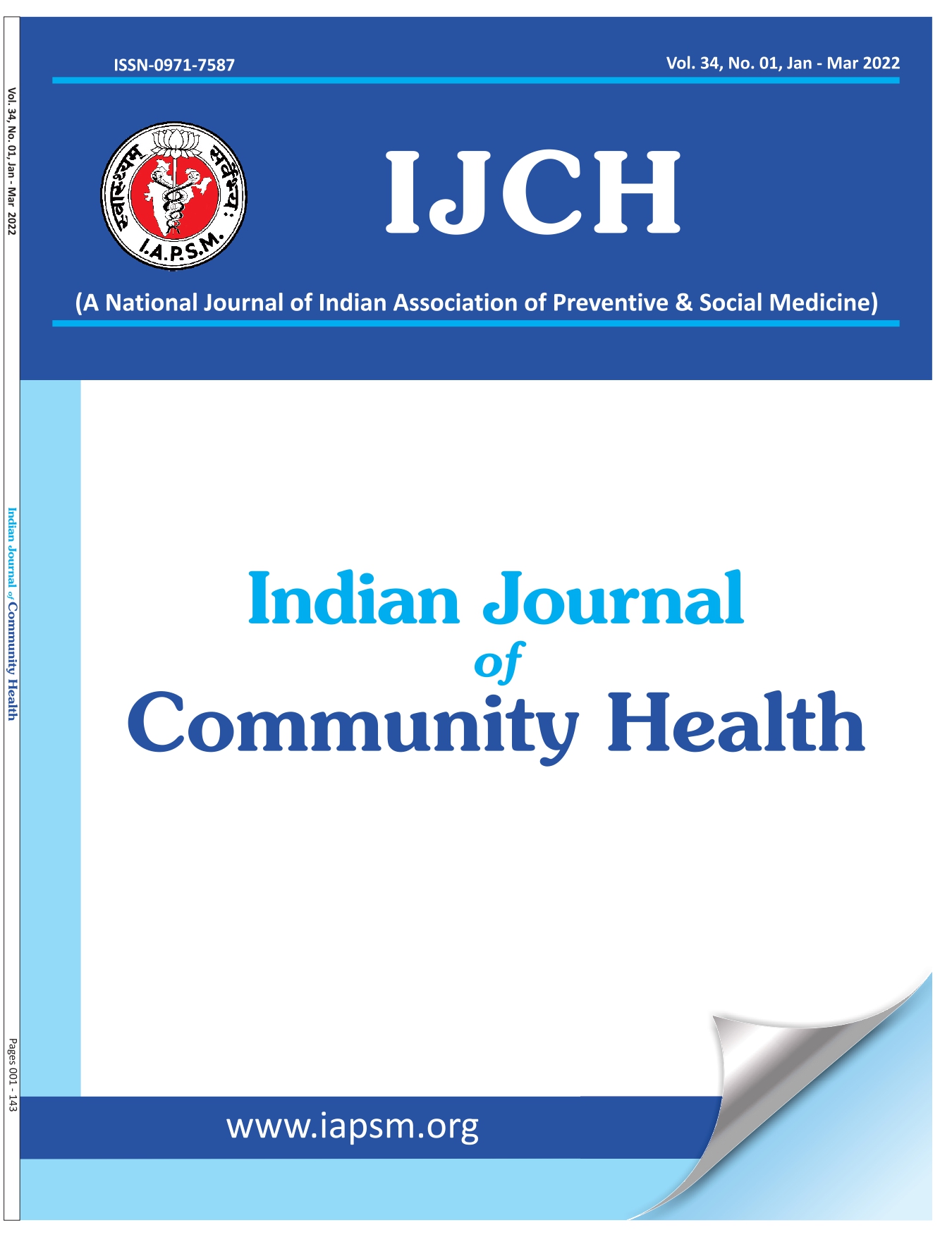Predictors of Male Sterilization among Eligible, Modern Method of Family Planning Users in India: Evidence from a Nationwide Survey
DOI:
https://doi.org/10.47203/IJCH.2020.v32i02.014Keywords:
India, Male, Sterilization, Reproductive, Family Planning Services, Health SurveysAbstract
Background: Male sterilization despite being more cost-effective compared to female sterilization is opted by very few Indian eligible couple as family planning (FP) method. Aims & Objectives: To find out attributes of male sterilization among current eligible modern family planning methods users in India. Material & Methods: It was an observational study, cross-sectional in design based on fourth round of national family health survey (NFHS-4) 2015-16 men’s datasheet. There were in total 112122 data, of which 11772 sample population who had completed their family, been using modern methods of family planning and wife in reproductive age (15-49) were selected for analysis. Results: Among the study subjects, 377(3.2%) underwent male sterilization. In multivariable model those who were residing in southern India; Hindu by religion; scheduled caste (SC)/scheduled tribe (ST) by caste; belonged to lower quintile of wealth index; covered by a health insurance scheme; perceived ?2 children as ideal number of children; husbands not working and employed seasonally/occasionally were more likely to undergo male sterilization adjusted with the age of husband, wife, their place of residence and property ownership status. Conclusion: Male sterilization in the sample population was significantly predicted by the region, religion, ethnicity, socioeconomic status, husbands employment status etc.
Downloads
References
Shattuck D, Perry B, Packer C, Chin Quee D. A Review of 10 Years of Vasectomy Programming and Research in Low-Resource Settings. Glob Health Sci Pract. 2016 Dec 23;4(4):647-660. doi: 10.9745/GHSP-D-16-00235. Print 2016 Dec 23. Review. PubMed PMID: 28031302; PubMed Central PMCID: PMC5199180.[PubMed].
Jacobstein R. The kindest cut: global need to increase vasectomy availability. Lancet Glob Health. 2015 Dec;3(12):e733-4. doi: 10.1016/S2214-109X(15)00168-0. Epub 2015 Nov 4. PubMed PMID: 26545447.[PubMed]
Ministry of Health and Family Welfare, Family Planning Division. India’s ‘Vision FP2020’. Government of India; 2014. https://advancefamilyplanning.org/sites/default/files/resources/FP2020-Vision-Document%20India.pdf
Census 2011. States Census 2011. Available from: https://www.census2011.co.in/ states.php. Accessed on 19/12/2019.
International Institute for Population Sciences. National Family Health Survey 2015-16: India Fact Sheet. http://rchiips.org/NFHS/pdf/NFHS4/India.pdf
International Institute for Population Sciences. National Family Health Survey 2005-06: Key Indicators for India from NFHS-3. http://rchiips.org/NFHS/pdf/India.pdf
Park K. Park’s Textbook of Preventive and Social Medicine. 25th ed. India: M/s Banarsidas Bhanot; 2013. p. 560-561.
Ministry of Health and Family Welfare. Reference Manual for Male Sterilization. Government of India; 2013. https://nhm.gov.in/images/pdf/programmes/family-planing/guidelines/Reference_Manual_for_Male_Sterilization-NSV-Oct_2013.pdf
Hardee K, Croce-Galis M, Gay J. Are men well served by family planning programs?. Reprod Health. 2017 Jan 23;14(1):14. doi: 10.1186/s12978-017-0278-5. Review. PubMed PMID: 28115004; PubMed Central PMCID: PMC5260026.[PubMed].
Valsangkar S, Sai SK, Bele SD, Bodhare TN. Predictors of no-scalpel vasectomy acceptance in Karimnagar district, Andhra Pradesh. Indian J Urol. 2012 Jul;28(3):292-6. doi: 10.4103/0970-1591.102704. PubMed PMID: 23204657; PubMed Central PMCID: PMC3507398.[PubMed].
Valsangkar S, Sai SK, Bele SD, Bodhare TN. Predictors of no-scalpel vasectomy acceptance in Karimnagar district, Andhra Pradesh. Indian J Urol. 2012 Jul;28(3):292-6. doi: 10.4103/0970-1591.102704. PubMed PMID: 23204657; PubMed Central PMCID: PMC3507398.[PubMed].
Egbe TO, Ketchen SA, Egbe EN, Ekane GE, Belley-Priso E. Risk factors and barriers to male involvement in the choice of family planning methods in the Buea Health District, south west region, Cameroon: a cross-sectional study in a semi-urban area. Women Health Open J. 2016;1(3):82-90.
Lamberts RW, Guo DP, Li S, Eisenberg ML. The Relationship Between Offspring Sex Ratio and Vasectomy Utilization. Urology. 2017 May;103:112-116. doi: 10.1016/j.urology.2016.11.039. Epub 2016 Dec 2. PubMed PMID: 27919667.[PubMed].
Anderson JE, Jamieson DJ, Warner L, Kissin DM, Nangia AK, Macaluso M. Contraceptive sterilization among married adults: national data on who chooses vasectomy and tubal sterilization. Contraception. 2012 Jun;85(6):552-7. doi: 10.1016/j.contraception.2011.10.009. Epub 2011 Nov 30. PubMed PMID: 22133657.[PubMed].
Ntakirutimana C, Umuziga P, Nikuze B, White R, Meharry P, Adejumo O. Vasectomy is family planning: factors affecting uptake among men in eastern province of Rwanda. Rwanda Journal of Medicine and Health Sciences. 2019;2(2):126-37.
Chang YH, Hsiao PJ, Chen GH, Chang CH, Chen WC, Yeh CC, et al. Economic fluctuation affects vasectomy utilization: A single-institution study. Urological Science. 2015;26(3):214-7.
Aji YM, Omotara BA. Attitude of Muslim men towards family planning in Borno state. European Journal of Human Resource. 2018;3(1):1-14.
Perry B, Packer C, Chin Quee D, Zan T, Dulli L, Shattuck D. Recent experience and lessons learned in vasectomy programming in low-resource settings: a document review. https://www.fhi360.org/sites/default/files/media/documents/resource-vasectomy-lit-review-final.pdf
Shafi S, Mohan U, Singh SK. Barriers for low acceptance of no scalpel vasectomy among slum dwellers of Lucknow City. Indian J Public Health. 2019 Jan-Mar;63(1):10-14. doi: 10.4103/ijph.IJPH_44_18. PubMed PMID: 30880731.[PubMed].
New JR, Cahill N, Stover J, Gupta YP, Alkema L. Levels and trends in contraceptive prevalence, unmet need, and demand for family planning for 29 states and union territories in India: a modelling study using the Family Planning Estimation Tool. Lancet Glob Health. 2017 Mar;5(3):e350-e358. doi: 10.1016/S2214-109X(17)30033-5. PubMed PMID: 28193400.[PubMed].
Ministry of Statistics and Programme Implementation. India in figures 2018. Government of India; 2018. https://mospi.nic.in/sites/default/files/publication_reports/India_in_figures2018_rev.pdf
Okigbo CC, Speizer IS, Corroon M, Gueye A. Exposure to family planning messages and modern contraceptive use among men in urban Kenya, Nigeria, and Senegal: a cross-sectional study. Reprod Health. 2015 Jul 22;12:63. doi: 10.1186/s12978-015-0056-1. PubMed PMID: 26199068; PubMed Central PMCID: PMC4508879.[PubMed].
Speizer IS, Corroon M, Calhoun LM, Gueye A, Guilkey DK. Association of men's exposure to family planning programming and reported discussion with partner and family planning use: The case of urban Senegal. PLoS One. 2018;13(9):e0204049. doi: 10.1371/journal.pone.0204049. eCollection 2018. PubMed PMID: 30252875; PubMed Central PMCID: PMC6155530.[PubMed].
Downloads
Published
How to Cite
License
Copyright (c) 2020 Indian Journal of Community Health

This work is licensed under a Creative Commons Attribution-NonCommercial-NoDerivatives 4.0 International License.





